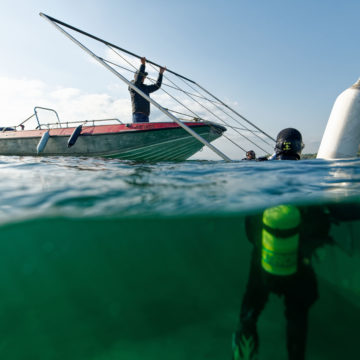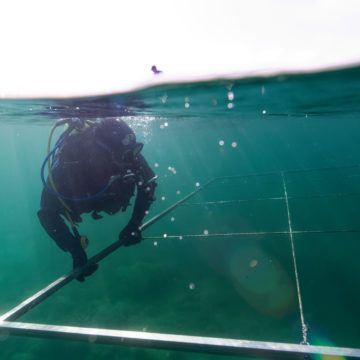
Prehistoric villages in Neuchâtel (Switzerland, 2022)
5000 years ago, men built wooden villages on the shores of alpine lakes. These “pile-dwellings” were eventually abandoned, their remains quickly covered by sediments deposited by rising water levels. Isolated from the air, fragile material such as wood has remained intact, representing an incredible source of information on the way our very distant ancestors lived. Today, some archaeological sites could be threatened by the joint effects of natural erosion and human activities.
Who could imagine that a few meters below the surface of Lake Neuchâtel, the remains of dozens of Neolithic and Bronze Age villages have lain intact for almost 5000 years for some of the oldest? These prehistoric pile-dwelling villages (or stilt houses) were erected by the first farmers of Central Europe. The sediments of the waters of the alpine lakes quickly covered the villages after they were abandoned. The remains were thus protected from the air and organisms that could have degraded them or caused them to disappear. Today, wood, fabrics, food, stone or bronze tools are still remarkably preserved in these veritable time capsules that are our lakes.
No other place on the planet offers such an explicit perspective of the evolution of Neolithic and Bronze Age village communities. The remains of these habitats are our main source of information on the agrarian societies of prehistoric Europe.

Experts have listed our distant ancestor’s pile-dwellings in the lakes of all the countries bordering the Alps: Switzerland, Germany, Austria, Slovenia, Italy and France. The 111 most important and best preserved villages still today were classified by UNESCO as World Heritage in 2011, as a unique object to be protected at all costs.
 This classification implies that it is up to each of the six countries to put in place precise tools to measure over time the evolution of the layer of protection that rests on each of these villages. Based on this information, archaeologists must take all necessary protective measures, without excavations, for future generations.
This classification implies that it is up to each of the six countries to put in place precise tools to measure over time the evolution of the layer of protection that rests on each of these villages. Based on this information, archaeologists must take all necessary protective measures, without excavations, for future generations.
Since 2019, the Octopus Foundation has been actively involved in several underwater excavations carried out by the archaeological departments of the Swiss cantons of Geneva and Neuchâtel. Each time, the scientific direction falls to the archaeologists of the canton concerned, and the excavation or monitoring operations in the water are carried out by the team of professional divers from the Octopus Foundation.
 More specifically, in 2019 and 2020, we assisted Fabien Langenegger in the discovery of three shipwrecks of major importance in Lake Neuchâtel. The oldest wreck dated back to the Gallo-Roman era, and the two others were proved to have sunk in the 16th and 18th century. Once studied and scanned in 3D, the fragile wooden remains were once again covered in a thick layer of sediment which proves to be the best protection against time and elements.
More specifically, in 2019 and 2020, we assisted Fabien Langenegger in the discovery of three shipwrecks of major importance in Lake Neuchâtel. The oldest wreck dated back to the Gallo-Roman era, and the two others were proved to have sunk in the 16th and 18th century. Once studied and scanned in 3D, the fragile wooden remains were once again covered in a thick layer of sediment which proves to be the best protection against time and elements.
In 2023, Fabien Langenegger and the archeology department of Neuchâtel is once again collaborating with the Octopus Foundation team. This ambitious project is planned to be a first in the field of underwater archeology.
The six countries bordering the Alpine arc (Switzerland, Germany, Austria, Slovenia, Italy and France) all have archaeological treasures in their lakes, thanks to the incredibly well preserved remains dating back to the Neolithic and the Bronze Age. Many pile-dwelling villages at that time were rapidly abandoned, later to be covered by major floods. Today, some of these most important villages are on the UNESCO’s World Heritage list. When an archaeological site is on the list, it is banned from being excavated to prevent any destruction.
With Fabien Langenegger, the Octopus Foundation wants to demonstrate that it is possible to carry out non-destructive excavations on an unclassified Neolithic village. Each object will be studied, modeled in 3D and replaced at the precise location of its discovery. At the end of this experimental mission, the two test areas will once again be covered by a protective layer of sediments and monitored.
Neolithic village of Bevaix-Treytel
This film (only in French) presents the underwater archaeological excavations that took place in Lake Neuchâtel (Switzerland) in March 2023. The project was done by the heritage and archeology office of the canton of Neuchâtel in partnership with the Octopus Foundation. The main objective was to study the feasibility of carrying out non-destructive excavations on two small sample areas. The studied remains dates from the final Neolithic period, around 2500 BC.
© OPAN and Octopus Foundation – 2023































